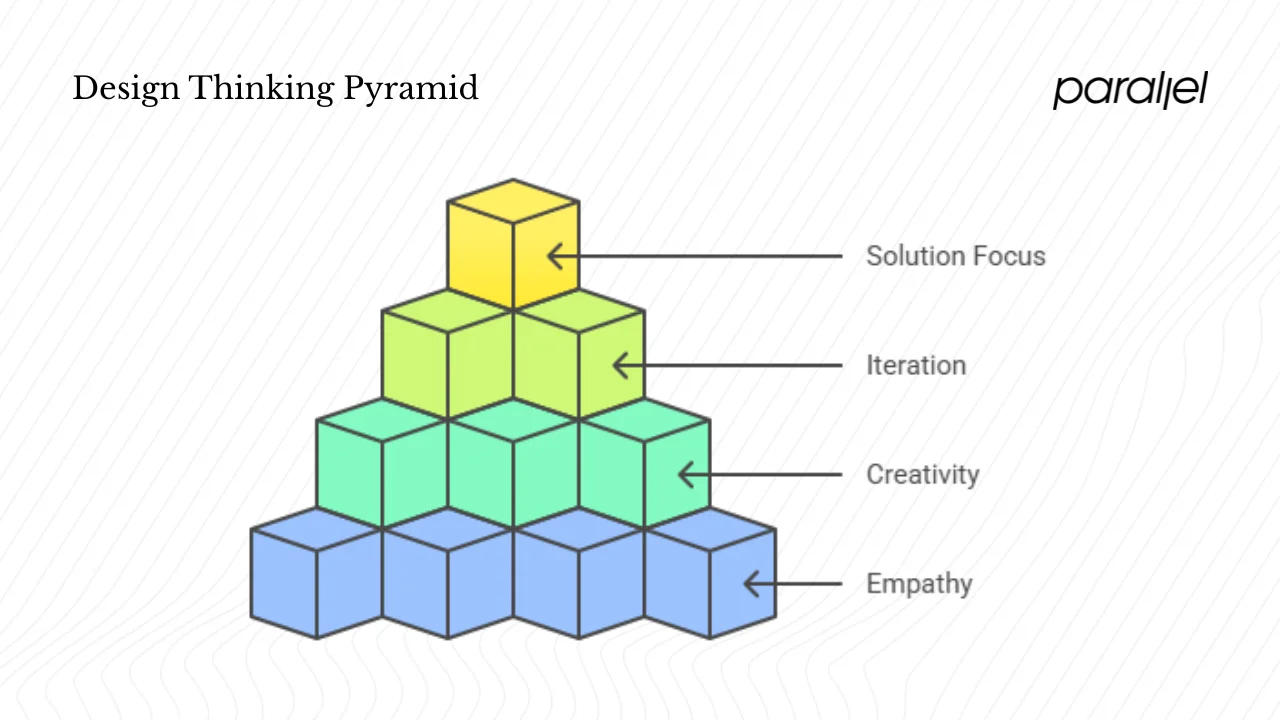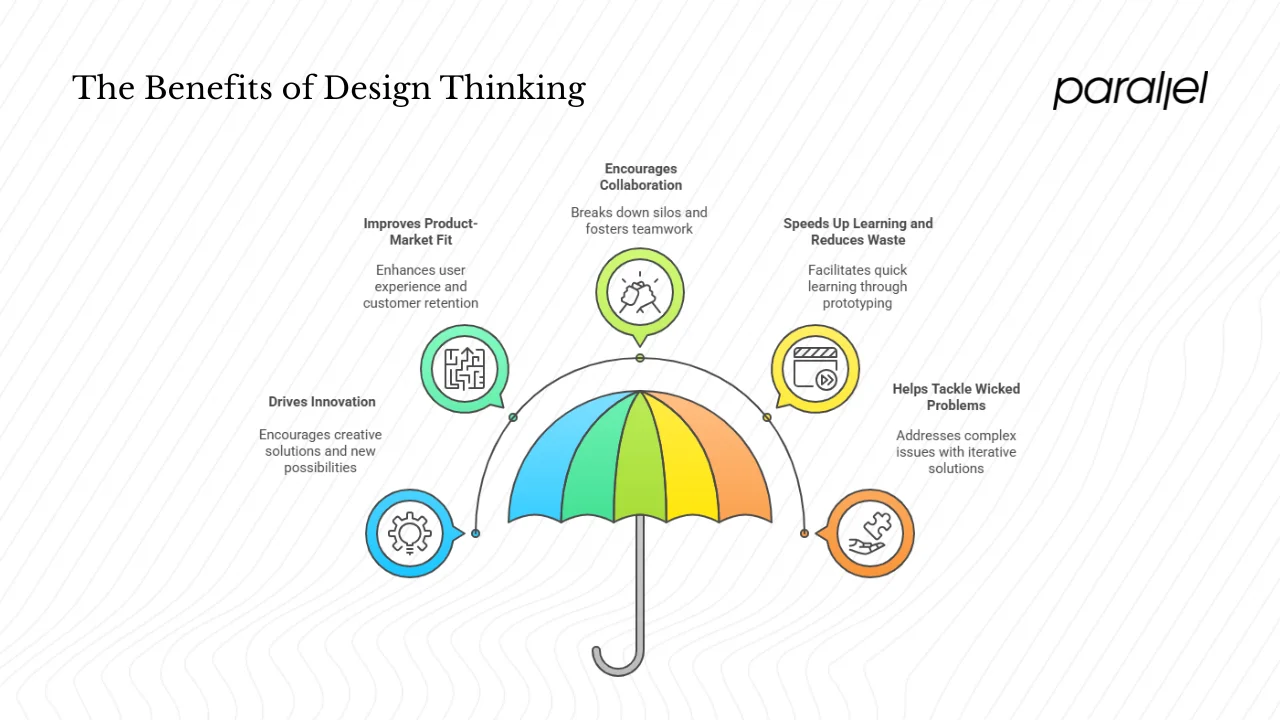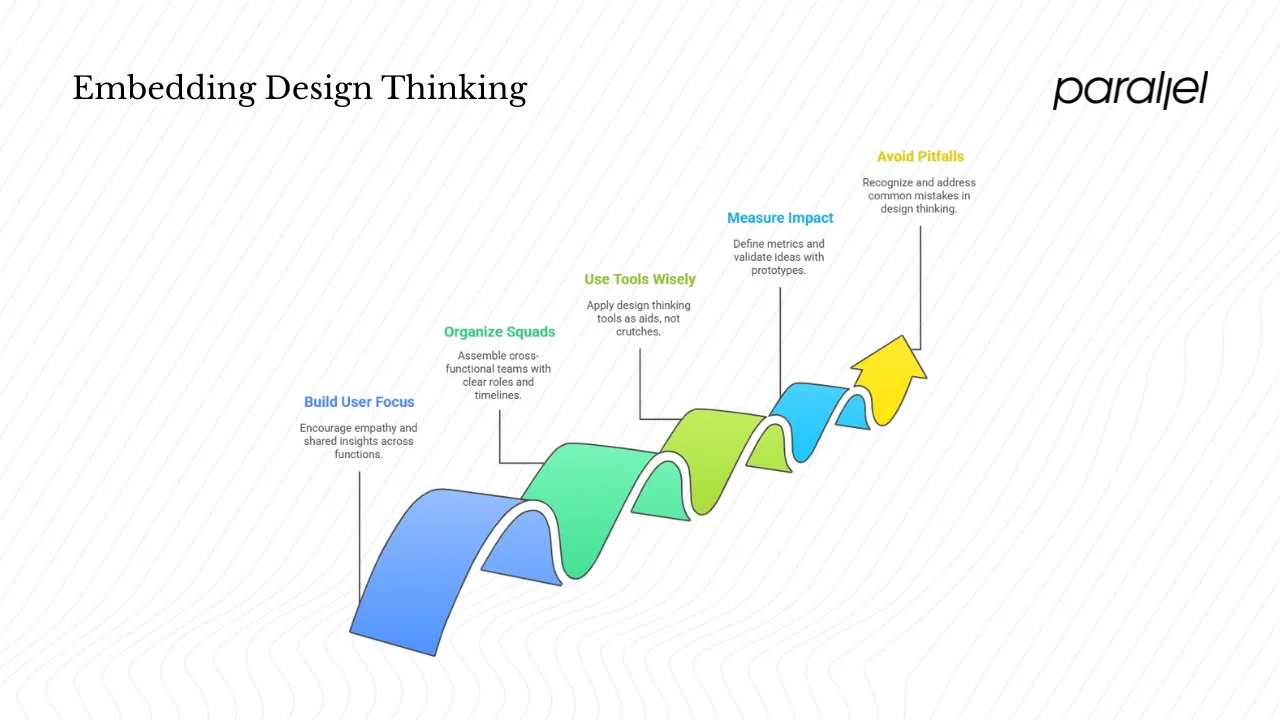What Is Design Thinking? Complete Guide (2025)
Explore design thinking, a human‑centered approach to problem‑solving involving empathy, ideation, prototyping, and testing.

Why care about what is design thinking when you’re running a young company or building a new product? In early‑stage environments it’s tempting to jump straight into coding when ideas and pressures pile up. A user‑centred, iterative process helps teams focus on the right problems and build solutions that matter.
In this guide you’ll learn what is design thinking in plain language, how its stages work and why it adds value. I’ll share examples from my experience with startups and product teams and offer practical steps to embed it into your workflow. The goal is to move from theory to practice so you can apply design thinking on your next project.
What is design thinking?
Design thinking is often defined as a non‑linear, iterative process used to understand users, challenge assumptions and redefine problems to create innovative solutions. It differs from traditional problem solving because it’s human‑centred and solution‑oriented rather than problem‑based. Tim Brown of IDEO calls it “a human‑centred approach to innovation that draws from the designer’s toolkit to integrate the needs of people, the possibilities of technology, and the requirements for business success”.

A user‑centred mindset
At the heart of design thinking is empathy. Instead of assuming you know what users need, you listen, observe and try to see the world through their eyes. This means interviewing customers, watching them use your product and immersing yourself in their environment. Empathy helps you move past internal biases and focus on the realities of those you serve. According to Harvard Business School, design thinking is a mindset and approach to problem‑solving and innovation anchored around human‑centred design.
Creative thinking and collaboration
Design thinking encourages teams to suspend judgement and generate a wide range of ideas. It values cross‑discipline collaboration. Varied teams bring different skills and experiences, which leads to richer solutions. Research by the Interaction Design Foundation defines cross‑functional teams as groups with different skills working toward a common goal and explains that their varied perspectives enhance the likelihood of reaching optimal solutions. In practice this means involving product managers, designers, engineers, marketers and even customer support in brainstorming sessions.
Iteration and prototyping
Another pillar of design thinking is building to learn. Instead of debating concepts endlessly, teams create quick, low‑fidelity prototypes—sketches, wireframes, or simple clickable models. By putting something tangible in front of users early, you can gather feedback and refine ideas before committing resources to development. The process is iterative: you may loop back from testing to ideation and redefine the problem as new insights come up.
Solution‑oriented focus
Unlike analytical problem solving that can dwell on what’s wrong, design thinking pushes teams toward actionable solutions. It combines empathy, creativity and experimentation to uncover opportunities. Human‑centred design is more than a buzzword; it encourages us to ask, “Who will use this and why?”. By keeping real users in mind at every step, you move towards solutions that are desirable, feasible and viable.
Why this matters for startups and product teams:
Early‑stage startups face uncertainty. The problem you set out to solve may not be the one your market cares about. Design thinking gives founders and product managers a structured way to validate assumptions, learn quickly and avoid building features no one wants. Cross‑functional collaboration ensures that design, product and engineering teams share a common language and process. This alignment supports rapid experimentation and helps teams adapt as they learn.
The stages of design thinking
The most common model includes five phases: empathise, define, ideate, prototype and test. Although described in order, the process is flexible; teams often revisit phases based on what they learn. In my practice I consider these phases as modes of thinking rather than rigid steps.

1) Empathise: understand the user
The process begins with empathy. In this phase you study your users—what they do, what they say, what they think and feel. Sarah Gibbons of Nielsen Norman Group describes this phase as conducting research to understand what users do, think and feel. Techniques include one‑on‑one interviews, field observations, shadowing and immersion. The goal is to gather enough observations to step into your users’ shoes and build a shared understanding across the team. In early‑stage startups this often means talking to potential customers before writing a single line of code.
2) Define: frame the problem
Once you’ve collected insights, synthesise them to define the core problem. This might involve creating point‑of‑view statements, user personas or user path maps. The Interaction Design Foundation points out that defining users’ needs and problems involves analysing observations and crafting problem statements. For startups this phase is about clarifying the real pain point. For example, you might realise that churn stems not from missing features but from a confusing onboarding flow. A clear problem statement guides ideation and keeps the team aligned.
3) Ideate: generate possibilities
Ideation is about generating a wide range of ideas without judgement. Brainstorming, brain‑writing, “worst idea” exercises and techniques like SCAMPER all encourage divergent thinking. IDEO teaches that the seven steps of design thinking include generating ideas after synthesising insights, making ideas tangible and testing to learn. During ideation I encourage teams to include engineers and marketers so that ideas reflect both user desirability and technical possibilities. Once a broad set of ideas exists, the team can converge on the most promising ones.
4) Prototype: make it tangible
In the prototyping phase you turn ideas into tangible artefacts. These can be paper sketches, interactive wireframes or even role‑playing scenarios. The aim is to visualise ideas and test assumptions quickly. Sarah Gibbons emphasises that prototypes help teams understand what components of ideas work and which do not. For startups, prototypes can be as simple as a landing page or a fake‑door test. The point is to gather feedback without committing to a full build.
5) Test: learn from feedback
Testing brings prototypes to real users. You observe how they interact, pay attention to what confuses them and ask open‑ended questions. This phase often loops back to empathise or define as new insights come up. In my experience this is where teams discover that their favourite idea isn’t as clear or valuable as they thought. Testing can reveal small tweaks that have large impacts on usability.
Variations and alternative models
Some frameworks expand or compress the phases. IDEO’s seven‑step process adds framing a question, gathering inspiration, synthesising for action, generating ideas, making ideas tangible, testing to learn, and sharing the story. Harvard Business School’s four‑phase model uses clarify, ideate, develop and implement. These variations remind us that design thinking is not a one‑size‑fits‑all process. Adapt the model to your context and team size, but keep the underlying principles: empathy, definition, ideation, prototyping and testing.
Other frameworks take different shapes. The British Design Council’s Double Diamond divides problem and solution spaces into four distinct phases—discover, define, develop and deliver—while Google’s design sprint compresses the process into a five‑day workshop. Choosing the right structure depends on your team, domain and timeline, but the goal remains the same: learning quickly from users and iterating on solutions.
Why it works: benefits and business value
Design thinking helps teams surface creative solutions to complex problems. It shines because it combines human insights with iterative experimentation. Here are some concrete benefits.

1) Drives innovation
By focusing on users’ needs and behaviours, design thinking opens up new possibilities. It encourages teams to move past default solutions and think creatively. Tim Brown’s definition emphasises integrating the needs of people, technology possibilities and business requirements. When teams apply this mindset, they often uncover unexpected opportunities. For example, a client of ours discovered that focusing on fewer onboarding steps, rather than adding features, improved trial conversion by 30%.
2) Improves product‑market fit
Investing in user experience pays off. According to research aggregated by Maze, every dollar invested in user experience design yields a return of $100. Another insight from the same report indicates that improving user experience to increase customer retention by just five percent can translate to a 25 percent rise in profit. These numbers show how understanding users and addressing their pain points leads to tangible business outcomes.
3) Encourages collaboration
Design thinking breaks down silos. Cross‑functional teams share perspectives and work toward a shared goal. The Interaction Design Foundation explains that traditional functional teams can become siloed, whereas cross‑functional teams bring together people from different departments to gain multiple perspectives. This diversity sparks ideas and prevents tunnel vision. In my experience, including engineers early in ideation leads to solutions that are both user‑friendly and technically feasible.
Research from 2024 highlights how critical creative thinking is for organisational success. Ninety‑six percent of respondents say fresh ideas are essential to long‑term performance and 94% believe companies that encourage them achieve greater growth. Yet only a small share of organisations support creative risk‑taking. This gap reinforces the need for psychological safety and leadership that encourages experimentation, rather than punishing missteps.
4) Speeds up learning and reduces waste
Iterative prototyping and testing mean you learn quickly and at low cost. By experimenting with low‑fidelity prototypes, you can identify flaws early and avoid building full features that fail later. This approach aligns with lean startup principles and reduces time to market. As the Maze report shows, 74% of respondents believe research is effective in determining decision‑making, and organisations with mature research practices are almost twice as likely to report improved customer satisfaction.
5) Helps tackle wicked problems
Wicked problems are complex issues with no clear solution. Design thinking is well suited for these challenges because it encourages teams to reframe questions and iterate on potential solutions. It is not limited to product design; social impact organisations use it to address systemic issues like financial inclusion and health equity. However, it’s important to recognise its limitations. A 2025 critique warns that applying design thinking mechanically can lead to “innovation theatre” where workshops don’t translate to sustainable change. Practitioners should stay mindful of context and adapt the methodology rather than follow it blindly.
Embedding design thinking in a startup or product team
Adopting design thinking is less about following a script and more about shifting the team environment. Here are practical steps.

1) Build a user‑focused environment
Start by encouraging empathy across functions. Make it everyone’s job to understand customers. Instead of waiting for designers to present findings, have product managers, engineers and even marketers join user interviews. As the Harvard research on creativity shows, teams that encourage creative risks and different ways of thinking are more successful. Encourage people to share what they learn and view insights as shared assets, not personal territory.
Create a safe space for experimentation. Early prototypes will fail. That’s normal. Frame failure as learning. Leaders must model this behaviour; if senior leaders punish mistakes, teams will revert to safe but uninspired solutions. On the flip side, teams with leaders who encourage creative risks see greater creativity.
2) Organise cross‑functional squads
For each project, assemble a small group including design, product and engineering. Assign someone to lead user research, another to manage prototyping and another to coordinate testing. Timebox each phase; for instance, allocate two days for empathy interviews, a day for synthesis, and so on. This keeps momentum and prevents analysis paralysis. Cross‑functional collaboration fosters broader perspectives and breaks down silos.
3) Use methods and tools wisely
Design thinking is filled with tools—user interviews, user path mapping, storyboarding and rapid prototyping. Use them as aids, not crutches. The Nielsen Norman Group warns against over‑reliance on workshops that don’t connect to implementation. Make sure that insights flow into product decisions and that prototypes lead to concrete changes. A user path map is helpful only if it informs design decisions.
4) Measure impact and tie to business goals
Design thinking isn’t just about feeling innovative; it should drive results. Define metrics up front. Measure user satisfaction (for example, Net Promoter Score), engagement and retention. Use quick prototypes to validate ideas before committing resources. Research shows that organisations with mature research practices are more likely to report improved satisfaction and revenue growth. Share these metrics with stakeholders to demonstrate value.
5) Avoid common pitfalls
From working with dozens of teams, I’ve seen several traps. The first is skipping empathy. When teams assume they know the problem, they often build solutions that miss the mark. Another pitfall is viewing design thinking as a linear checklist. Real projects rarely follow a straight path; loops and iterations are normal. Also, avoid isolating design thinking within the design team. Engage engineers, marketers and even support staff. Finally, always test with real users. Internal opinions are not a substitute for feedback from the people you serve.
Real‑world examples
Example 1: Finding a hidden user pain and pivoting
A SaaS startup thought missing integrations were its main issue. Empathy interviews and watching users onboard revealed that the real pain was an overwhelming sign‑up flow. By reframing the challenge to simplify onboarding, the team built a prototype that reduced initial fields from ten to three and delayed the rest. After testing and rollout, trial conversions rose by 40%, and the integration work was postponed until demand was validated.
Example 2: Refining a feature through empathy and prototypes
Another product team considered a suggestion engine to boost engagement. User interviews showed that people were overwhelmed by the interface itself rather than lacking suggestions. The team reframed the problem, brainstormed with engineers and marketers, and prototyped a simplified dashboard with personalised tips. Testing showed users felt more in control; after launch, session duration rose 25% and support tickets were halved.
Example 3: Improving user onboarding with cross‑functional collaboration
A large B2B platform team formed a cross‑functional squad to improve onboarding. Shadowing new customers revealed that instructions were buried in long support articles. They designed and prototyped an interactive setup wizard and paired it with optional human support. After release, time to first value fell 30%, and month‑one retention improved 20%.
These examples show that what is design thinking isn’t just a buzzword; it’s a practical way to uncover hidden problems, generate ideas and test them quickly. When applied with intention, it drives measurable results.
If you’re still asking yourself what design thinking is, consider the pattern across these stories: teams began by listening, reframed the problem with a user lens, generated many possibilities and quickly tried them out. That simple rhythm—empathy, definition, ideation, prototyping and testing—is the essence of the method.
Conclusion
Design thinking combines a user‑centred mindset with creative collaboration and iterative experimentation. It helps teams understand what is design thinking by moving through phases of empathy, definition, ideation, prototyping and testing. For startups and product teams it offers a structured yet flexible framework to manage uncertainty, avoid wasted effort and improve product‑market fit. The method’s strength lies in its adaptability—use it as a set of principles rather than a rigid formula. As the 2025 critique points out, design thinking must adapt to complex problems and integrate with systems thinking and artificial intelligence. That evolution is already happening, with practitioners combining human insight with machine intelligence and expanding focus from individual users to communities.
If you’re new to design thinking, start simple. Pick a real challenge, talk to users this week, craft a problem statement, and sketch out a prototype. Iterate based on feedback. The value of this guide comes not from reading it but from applying it. What is design thinking? It’s a way to bring empathy, creativity and action into your work—and the best way to learn it is to practise.
FAQs
1) What is design thinking in simple words?
Design thinking is a process and mindset that helps teams understand what is design thinking by focusing on people’s needs, challenging assumptions, generating many ideas and testing them quickly. It encourages empathy with users, collaboration across disciplines and learning through iteration.
2) What are the five stages of design thinking?
The classic model has five phases: empathise (research user needs), define (frame the problem), ideate (generate ideas), prototype (build quick models) and test (get feedback and refine). Some organisations add implementation or storytelling phases, but the core activities remain the same.
3) Can you give examples of design thinking?
Yes. A startup simplified its onboarding flow after discovering that users were confused by too many initial fields. A product team improved engagement by replacing a planned suggestion engine with a simplified dashboard that addressed user overwhelm. A cross‑functional squad improved onboarding by combining an interactive setup wizard with optional human support. These examples show design thinking in action.
4) What is the main goal of design thinking?
The main goal is to solve the right problems for the people you serve by combining empathy, creativity and experimentation. It’s about creating solutions that are desirable for users, technically feasible and commercially viable. By following this approach, teams make better decisions, reduce waste and deliver products that people genuinely value.

.avif)











